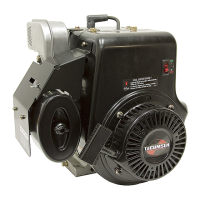78
ENGINE VIBRATES EXCESSIVELY
1. Check the engine crankshaft on the PTO end for bends using a straight edge, square or a dial indicator. Blades or
adapters must be removed. Any deflection will cause a vibration problem.
2. Check the engine mounting bolts, make sure they are tight.
3. Remove and check the attached equipment for an out of balance condition.
4. If the engine is equipped with a counterbalance shaft, check the gear timing to determine if the counterbalance is
out of time.
BREATHER PASSING OIL
1. Check the oil level, make sure the engine is not overfilled. Also verify that the viscosity rating on the container of
the oil being used is to specification.
2. Check the angle of operation. Avoid prolonged use at a severe angle.
3. Check the engine R.P.M. setting for excessive R.P.M. using a vibratach or other tachometer and compare it to the
R.P.M. settings found on microfiche card # 30 according to the engine model and specification number. Adjust the
high and low R.P.M. as necessary.
4. Check for leaking or damaged gaskets, seals, or "O"-rings. External leaks may not be evident; however, the leak
may prevent the engine from achieving a partial crankcase vacuum.
5. Check the breather for damage, dirty condition, or improper installation. The oil return hole(s) must face down.
6. Check the engine compression using a compression tester. If the engine has weak compression, determine the
cause of weak compression: worn rings, leaking head gasket, or leaking valves. Follow the compression tester's
procedure.
EXCESSIVE OIL CONSUMPTION
1. Check the oil level, oil viscosity on the container of the oil being used, and oil condition. Replace and fill to the
proper level.
2. Check the angle of operation. Avoid prolonged use at a severe angle.
3. Check for leaking or damaged gaskets, seals, or "O"-rings. External leaks may not be evident, however, the leak
may prevent the engine from achieving a partial crankcase vacuum.
4. Check the engine R.P.M. setting using a vibratach or other tachometer and compare it to the R.P.M. settings found
on microfiche card #30 according to the engine model and specification number. Adjust as necessary.
5. Check the breather for damage, dirty condition, or improper installation. The oil return hole(s) must face down.
6. Clean the cooling fins to prevent overheating.
7. Check the carburetor setting causing a lean running condition, overheating the engine.
8. Check the engine compression using a compression tester. If the engine has weak compression, determine the
cause of weak compression: worn rings, leaking head gasket, or leaking valves. Follow the compression tester's
procedure.
9. Check the valve guide clearance for excessive wear.
LACKS POWER
1. Check the air intake for an obstruction (dirty filter, oil saturated filter, other debris).
2. Check the oil level, oil viscosity on the container of the oil being used and oil condition. Replace and fill to the
proper level.
3. Readjust the carburetor or remove the carburetor for cleaning. See Chapter 3 under "Service."
4. Check the exhaust for a restriction preventing proper exhaust flow.
(continued on top of next page)

